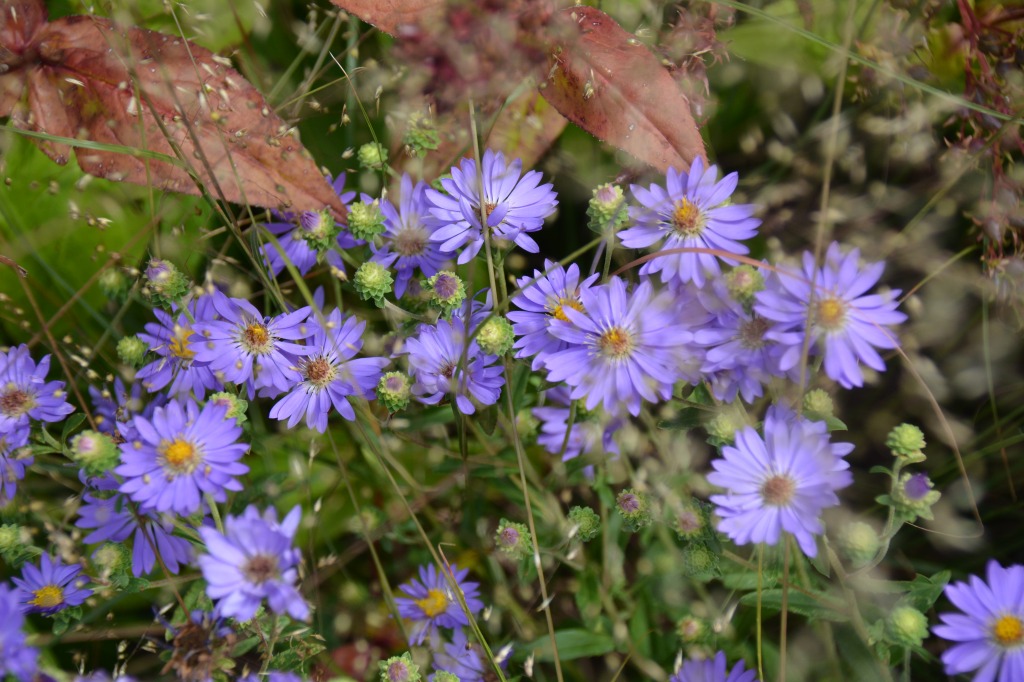You may notice our plant inventory and online plant list still feature the genus Aster. You may be of a certain age to remember when Asters were Asters. Though the name changes happened in the early 2000s and are based on a 1994 genetic study of all asters, you, like us, may still be having a difficult time accepting the new, complicated names of our most familiar asters.
As a reminder for those of you who learned your plants prior to the early 2000s:
Aster azureus is now Symphyotrichum oolentangiense
Aster cordifolius is now Symphyotrichum cordifolium
Aster ericoides is now Symphyotrichum ericoides
Aster divaricatus is now Eurybia divaricata
Aster laevis is now Symphyotrichum laeve
Aster macrophyllus is now Eurybia macrophylla
Aster novae-angliae is now Symphyotrichum novae-angliae
Aster novi-belgii is now Symphyotrichum novi-belgii
Aster oblongifolius is now Symphyotrichum oblongifolius
Aster puniceus is now Symphyotrichum puniceum
Aster spectabilis is now Eurybia spectabilis
Aster umbellatus is now Doellingeria umbellata (Mill.) Nees
For many of you this is old news.
Why did these names change?
Before we get to why these specific names change, let’s talk a little bit about the variety of reasons scientific names may change.
And before we get to that, let us recommend The Plant List which is an online working list of all plant species. All.Of.Them. This is the definitive resource for checking to make sure you have the most up to date scientific name of a plant for your labels, signage, catalogs etc etc. (Not us, we are not yet ready to make the change – but you – go for it and check out the plant list!) This list is a collaboration of horticultural organizations and lists the accepted species names and their synonyms.
Also, if you are new to binomial nomenclature – check out this great blog post on botanical names for beginners from the NYBG.
So, why do names change?
Another informative blog post from the NYBG explains the codes and processes of formalizing a scientific name, and the common reasons why names change.
Scientific names, sometimes called Latin names, which isn’t technically accurate because many scientific names are not Latin, but Greek or contain mixes of various languages, are universal. (If you have some time to spend, check out this list of scientific names named for famous people.) This is to say they are the same no matter where you go on Earth to talk plants to people if you use the scientific name you will be talking about the same plant.
One of the challenges of scientific names is that when good ol’ Carl Linnaeus (His father having changed his own surname, naming himself after the Linden Tree – for more information on the history of scientific names, colonization, erasing names of plants given by indigenous people, and Carl Linnaeus please read In History by Jamaica Kincaid.) started giving living things 2 names in the mid 1700s we did not have the ease of global travel and communication that we do today.
In some cases, the same species was given different names by different people and it wasn’t figured out until later.
The rules state that the plant gets the scientific names that was documented first.
We are also having more names changed as technology lets us know more about the genetics of the plants. When Linnaeus was first naming living things he was using field observations, reproductive structure descriptions and other characteristics to group plants together. Now that genetic mapping is possible, it is possible to see exactly which plants are related to which, beyond just having features that look the same.
This is what happened with our beloved, easy to pronounce, won’t-lose-points-for-spelling on this week’s herbaceous quiz, Aster. As researchers, in that 1994 study, determined that the eurasian aster species were genetically distinct from the north American native species. Within those North American native species a number of distinct groups were discovered. This resulted in the North American Native species changing from Aster (which is what the Eurasian species are still called) to the melodic Symphyotrichum and easy to spell Eurybia and rolls-off-the-toungue Doellengeria.
This study also demonstrated that our North American native asters are more closely related to other familiar natives such as Solidagos and Boltonia than to the Eurasian species of Asters.
Now you know the story behind the mystery of the Aster name changes, when we will update our catalog to reflect this change still remains a mystery.
Reference with some great references: http://www.guynesom.com/NameChangesInAsterWEB.htm

Are you thinking that if we are going to change plant names, perhaps we change them to honor Indigenous people instead of the colonizers who felt the need to name everything to own it? Check out this article.








[…] Sage – Perovskia atriplicifolia (Did you know this has a new name? Salvia […]
[…] the past we have had some fun with our plants’ names and we have expressed our frustration with seemingly constantly changing plant names but we also need to address some of the problematic plants on our lists. Sorghastrum nutans is one […]